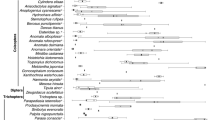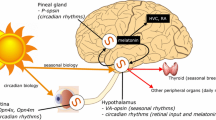Abstract
FEW data are available concerning the environmental factors involved in the ‘timing’ of the reproductive cycles of equatorial birds. The annual fluctuation of day-length on the equator is only about two minutes. Wolfson1,2, considers it possible that “summation of daylengths or the daily dose of light”, rather than increasing day-lengths as such, might be the critical environmental factor in determining the periods of migration and breeding of equatorial, as well as other, species.
Similar content being viewed by others
References
Wolfson, A., Sci. Mon., 74, 191 (1952).
Wolfson, A., Condor, 55, 187 (1953).
Scott, H. M., and Payne, L., cited by Marshall, F. H. A., Biol. Rev., 17, 68 (1942).
Brown, F. A., and Rollo, M., Auk, 57, 485 (1940).
Rollo, M., and Domm, L. V., Auk, 60, 357 (1943).
Marshall, A. J., Quart. J. Micro. Sci., 90, 265 (1949).
Whetham, E. O., J. Agric. Sci., 23, 383 (1933).
Marshall, A. J., “Reproduction in Male Birds”. Chapter in “The Comparative Endocrinology of Vertebrates” (London, 1955).
Author information
Authors and Affiliations
Rights and permissions
About this article
Cite this article
MARSHALL, A., DISNEY, H. Photostimulation of an Equatorial Bird (Quelea quelea, Linnæus). Nature 177, 143–144 (1956). https://doi.org/10.1038/177143a0
Issue Date:
DOI: https://doi.org/10.1038/177143a0
- Springer Nature Limited
This article is cited by
-
Postjuvenile molt in east African and Central European stonechats (Saxicola torquata axillaris, S.t. rubicula) and its modification by photoperiod
Oecologia (1983)
-
Allgemeiner teil
Journal für Ornithologie (1966)
-
Effect of Photoperiod on the Gonadal Cycle in an Equatorial Bird, Quelea quelea
Nature (1959)
-
Duration of the Regeneration Period of the Internal Reproductive Rhythm in a Xerophilous Equatorial Bird, Quelea quelea
Nature (1959)
-
Experimental Induction of the Breeding Season in a Xerophilous Bird
Nature (1957)





